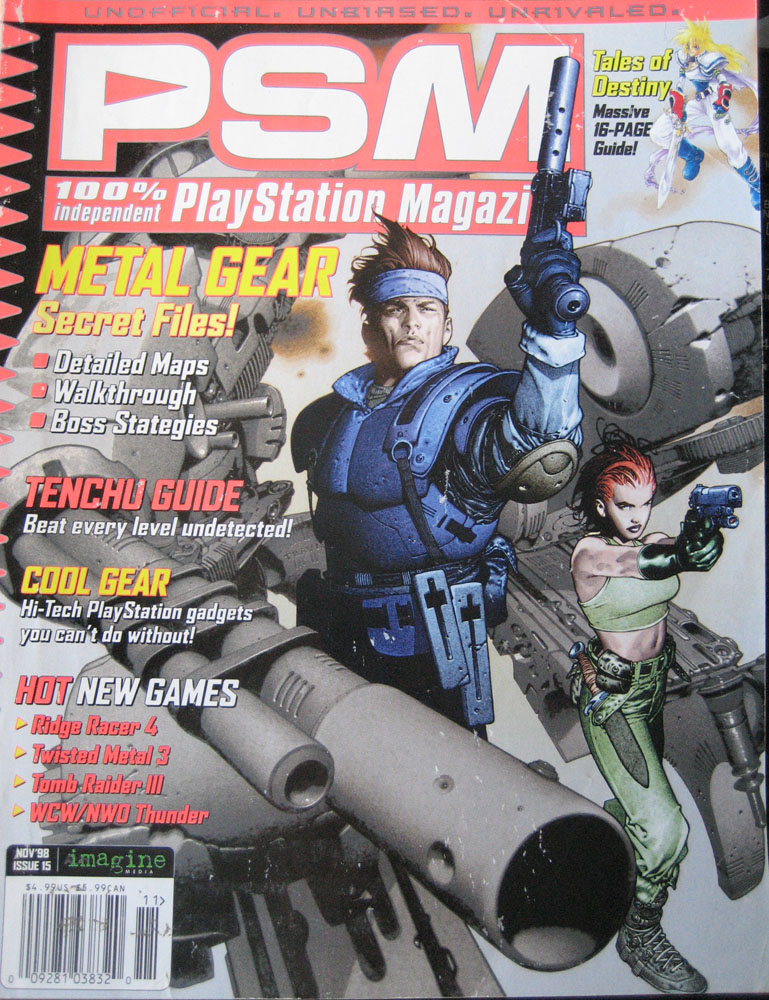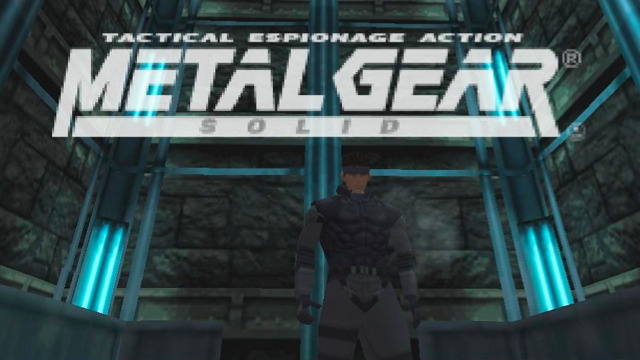In September, I wrote a tribute to a 1998 stealth game that changed my life. In those days, as I enjoyed playing that game repeatedly for hours, days, and weeks while mastering every enemy layout, I noticed that in gaming magazines such as EGM, GamePro, GameFan, and PSM, a certain stealth-themed game was garnering coverage as a Japanese import, released overseas September 3, 1998. Last month, most gaming outlets released articles celebrating the fifteen-year anniversary of Metal Gear Solid (MGS), the game that would transform the entire industry, despite the fact that the most popular release of the game was the North American release of October 21, 1998. I only remember this because I had to wait four days after my birthday to cash in on my preorder at Babbages.

Also note the reference to “that OTHER 1998 Stealth Game” on the front page!
I could (and still can) not read Japanese, but at fourteen going on fifteen, I could recognize hype when I saw it. That Babbage’s I mentioned was even giving away a free T-shirt for MGS preorders. In those days, gaming gear outside of Japan was as rare as Chicago Cubs World Series championship; the typical American (or European) could only read about gaming paraphernalia in the magazines. This promotional item made me realize that this game was going to be serious business. (1998 was a good year for game reservations; I got a T-shirt for Tekken 3 earlier that year.)

“Serious business” as in, the game opens with real-time cinematics, a substantial digression from earlier PS1 tradition where the (re)introduction of the CD-ROM (as previously seen on Sega CD!) as the cutting-edge format for gaming media allowed developers to do two things:
1. Include “compact disc quality” soundtracks, a tremendous upgrade from Musical Instrument Digital Interface, better known as “MIDI” from the Windows 95 days, which began a trend where gamers could pop their games into their CD players and listen to the soundtracks (I hope I am not the only person who listened to games like Loaded, Tomb Raider, and KoF ’95 more than the radio while driving around town)
2. Include full motion video, a feature that was used sparingly in cartridge-based games due to the massive amount of space that video requires, and a feature that Sony in particular wanted to use to distinguish itself from the Nintendo 64. In fact, Final Fantasy VII fans will fondly recall that one of the game’s selling-points (besides perhaps being even more hyped than MGS) was a then record-breaking ten minute-long ending video. However, while FFVII integrated FMV with real-time polygons placed upon pre-rendered backgrounds, such as in the legendary introduction of Aerith which transitions to renegade team Avalanche leap off a train while on its latest mission to sabotage a Materia factory, Konami, at the peak of PS1’s graphical production, chose not to include any FMV at all. Instead, gamers would receive a game with unprecedented production values, inducing a fully orchestrated soundtrack, a cast of professional voice actors who were not even sure if working on video games was sanctioned by the Screen Actors Guild because such an ambitious production was unheard-of and an eight million dollar promotional budget! Such a game had to deliver, right?

Wow, did it ever! Many gamers fondly remember playing the demo repeatedly just to witness this sequence: as the periodically flash upon the screen, Snake swims through water of sub-zero temperatures, evades (or dispatches, should players elect to exercise lethal methodologies against) the guards in the aqua bay, and ascends the elevator while shedding his excess equipment to maximize his stealth factor. The puff of exhalation emanating from Snake’s face during his climb punctuates the manifestation of the titles screen, if not his upward glance toward his destination. Not since X-Men 2: Clone Wars on the Sega Genesis have I played a game with a more immersive introduction.
Such attention to detail is consistent throughout the game, as genome soldiers might investigate foot tracks Snake leaves in the snow, or investigate the sound of Snake knocking on a wall around the corner. While experts who have spent years playing the game might make the AI appear remedial, in 1998, soldiers who would look into the cargo area of trucks or under tanks while chucking grenades was a pleasant change of pace from the mindless goons plaguing the games spawned from the Doom-clone fad of 90’s.

With a cast of professional voice actors, we get a cast of diverse characters. Roy Campbell, Naomi, and Otacon are the most well-known of the CODEC support crew. But the highlight of MGS and the ensuing series is Foxhound. In every great work of fiction, the protagonist must face antagonists who put the hero to the test, and MGS delivered to such a degree that with every new iteration of the franchise, Hideo Kojomia had to step up his game. By far, my favorite of the cast of MGS is Psycho Mantis, and any gamer who has fought him knows why, with a fight sequence clever enough to remind me of how one escapes Mojo’s Crunch in the Genesis version of X-Men. Speaking of X-Men, FoxHound are reminiscent of them, or more accurately, The Brotherhood of Mutants, as each member either possesses or demonstrates some fantastic characteristic that renders them…uncanny. Shunning all of the advanced weaponry available to him, Revolver Ocelot prefers to use a six-shooter, and he does so with finesse as he targets Snake by ricocheting shots against the ground and walls. Psycho Mantis is a telekinetic and telepathic like a fusion of Professor X and Jean Grey of the X-Men, taunting Snake as he dodges attacks, “USELESS! I can reeeead your mind!”
I could elaborate in a formal way many other features of this game, but I would like to break protocol and simply gush over this game. Spoilers ahoy!
-Companies like Millennium and Versus Books made detailed and clever strategy guides in the days before Prima and BradyGames started making bogus strategy guides based upon beta versions of games.
-That awesome title screen sequence, establishing the awesomeness of the game. OH THE FEELS!!!
–VR training missions featuring the music from MGS 1.
-A SDV is a real thing???
-Liquid Snake shoots down two F-16s with a Hind D. Later, Snake shoots down said Hind D with a Nikita Missile
-C4
-Man vs Tank (see next entry)
-After every boss fight, Snake takes a cigarette drag, increasing his max health.
-A ninja!!!! And in case you did not know me, I love ninja.
-The elevator scene that freaked me out.
-Snake’s obsession with Meryl’s butt, which he references twice, which, in the 90’s era, resembled something from the Buns of Steel videos, in contrast to the derriere standards of the 21st century.
-Sniper Wolf’s wolves.
–A sniper shootout, complete with Diazepam, that is significantly less frustrating (and thus, more fun) than the sniper fight in MGS3 (which the pros of MGS3 make it look easy).
-Fist fight showdown with the other l’enfant terrible and the escape.
-Support of Sony’s Dual Shock controller (released to compete with the Rumble Pak that Nintendo had released in 1997).
-Snake’s death cry